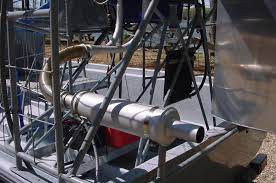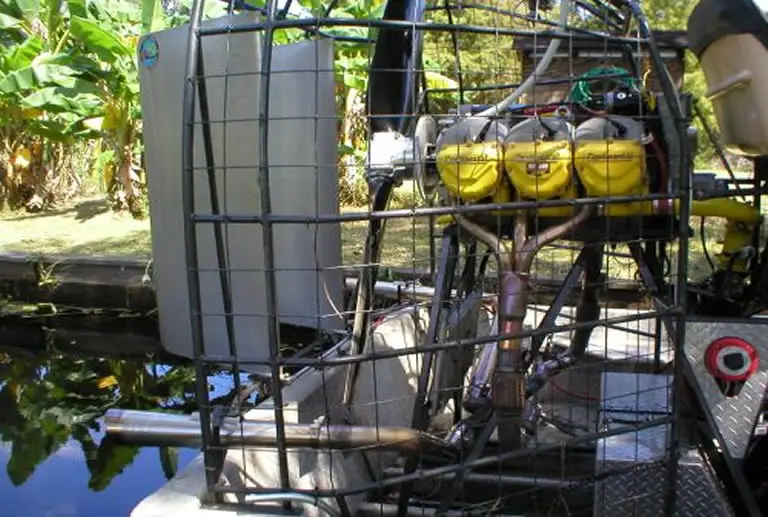Why Don’t Airboats Have Mufflers And Is There A Way To Quiet These Machines?
Mufflers can be fitted to airboats and many boats use them.
In Florida it is a legal requirement to fit a noise reduction system to an airboat.
However, muffling engine sound is not enough to appreciably reduce the noise from an airboat.

The propeller spins at almost mach speed and creates much of the noise associated with an airboat.
Modern carbon composite propellers have been designed to greatly reduce this noise.
Mach speed equals much noise
The sound of an airboat as it speeds across the water can reach about 100 – 110 decibels.
As the revs go higher, when the engine is being gunned, these decibels can reach 120+. That’s loud, and it’s more than just annoying.
This type of noise is actually very dangerous to your hearing.
If a sound reaches 85 decibels, or stronger, it can cause permanent damage to your hearing.
Consumers Reports stated that noise levels at 100 decibels or more cause permanent damage to hearing in as little as 15 minutes.
When you think that a modern jet engine produces between 120 – 140 decibels, and an airboat runs at about 110 decibels, you should start to get a feel for how just how loud an airboat is.
Airboat engines can have 700 to 1,000 horsepower with many have no effective form of dampening the noise generated by such a powerful machine.
Some engines on modern airboats are small aircraft engine while others are equally powerful Chevy engines.
These engines run at top revs and thus create a lot of noise.
Then there’s the propeller.
The prop can consist of 8 – 10 steel blades that rotate at almost mach speed.
A prop on an airboat usually produces a very high pitched wail while the motor exerts a low frequency roar and this combined sound can be heard up to five miles away.
Obviously this level of noise requires people on the airboat to wear ear protection to avoid permanent hearing damage but what about people who aren’t on the boat?
Many people who vacation, or live in, tranquil areas of natural beauty don’t want to be bombarded by the aircraft level noise from a fan boat.
Aircraft service providers encounter similar problems.
So, aircraft manufacturers have tried to address this problem with, most notably, Cessna aircraft being fitted with mufflers that greatly reduces the noise from the engines.
So if Cessna, and most single prop aircraft for that matter, can have mufflers fitted on them why can’t an airboat.
Why all airboats in Florida have mufflers
In the early 2000’s Florida law makers had there own problems with noise as they were constantly being bombarded by residents of the state who wanted them to put restrictions on the noise levels made by airboats.
Finally they tired of all the voter noise and in October of 2006 Chapter 327.391 of the Florida Statutes came into law requiring:
“… the exhaust of every internal combustion engine used on any airboat operated on the waters of Florida to be provided with a stock factory muffler, underwater exhaust, or other manufactured device capable of adequately muffling the sound of the exhaust of the engine”.
Since then you can’t take an airboat on Florida waters unless it is fitted with a noise suppression system of some kind.
Has this reduce the noise levels from airboats?
Yes, it has.
But has it reduced it by enough to make a difference?
That requires a more complicated answer.
It’s not just about the engine noise
Fitting a muffler on an airboat will reduce the noise that the engine makes but there are other considerations.
Even forcing the exhaust system to a place underneath the boat, which messes with the draft of the vessel and affects how it can be used, doesn’t reduces the noise levels adequately enough for most people. though
Many people believe that an airboat is just designed in a way that it cannot avoid making a lot of noise.
Even with a muffler an airboat will exceed 90 decibels at full throttle but all that noise isn’t coming from the engine.
In fact, even if you were to entirely eliminate the sound of the engine those decibels wouldn’t disappear?
Why is this?
Well, it’s because of that giant fan at the back of the boat!
The propeller in the fan of an airboat can be an actual airplane propeller or a specially made prop that resembles an airplane propeller.

These things are designed to create a huge amount of thrust and they make a lot of noise.
For example a 72″ propeller spinning at 3000 rpm will hit 642.6 mph, while a 48″ propeller spinning at 4500 rpm will also reach 642.6 mph.
When a military jet airplane flies at mach speed (faster than the speed of sound) it is going at approximately 761 mph. At that speed the plane creates a sonic boom that is loud and disturbing.
So when you consider that an airboat propeller is reaching 642.6 mph you can tell just how loud it is.
It is only about 100 mph away from creating a sonic boom, so of course it is going to be loud.
The tips of the propeller whizzing through the air at almost mach speed is what is responsible for most of the tremendous racket that an airboat makes.
This is the unfortunate thing about the noise created by an airboat.
Attaching mufflers and forcing the exhaust system under the water can have a degree of benefit in reducing noise levels and mufflers can also help the motor idle better.
Unfortunately though, it does not reduce the noise levels sufficiently enough to make a huge difference for most non-airboat-owners who have to listen to it.
How to quiet an airboat
So is all lost?
Are airboats doomed to be the nosiest watercraft on the water?
No … they aren’t, thanks to modern scientific breakthroughs and some clever designers.
By far the biggest noise reduction step you can take on an airboat is to replace the current noisy propeller with one of the newer quieter types.
Propeller noise has been such a problem for such a long time that manufacturers seen a big gap in the market for quieter propellers and fought one and other to fill it.
New carbon composite propellers seriously reduce propeller tip noise while the design ensures they still produce the same, or more, thrust than a traditional airplane prop.
Airboat with carbon prop – quiet approach (video)
Whisper Tip propeller on airboat (video)
Take a holistic approach
With super quiet props now available, such as the Whisper Tip, and the ready availability of mufflers, modern airboats do not need to be ear-shattering rivals to jets planes any longer.
The best way to quiet an airboat is to take a holistic approach.
Rather than focusing on reducing the noise from just one area of the boat target different areas.
By making even small noise reductions in multiple parts of the boat you will greatly reduce the overall noise created by your airboat.
Obviously the first point of call in the quieting process is to use mufflers.
Although this may not be enough to reduce the noise levels enough to satisfy your neighbors it will help.
Next, and if it is feasible and does not affect the performance of your boat, (and you don’t plan to glide on ice), then consider moving the exhaust system underneath the boat where the water will naturally muffle the sound.
Finally get a quiet carbon composite propeller.
Take these steps and, as long as you don’t go gunning the engine on a frog hunting trip at night, your neighbors will have little to complain about!

